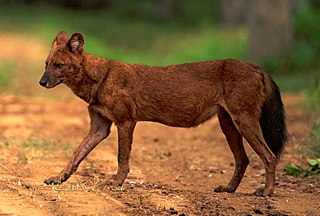
The International Union for Conservation of Nature (IUCN) Red List of Threatened Species, also known as the IUCN Red List or Red Data Book, founded in 1964, is an inventory of the global conservation status and extinction risk of biological species. A series of Regional Red Lists, which assess the risk of extinction to species within a political management unit, are also produced by countries and organizations.
The conservation status of a group of organisms indicates whether the group still exists and how likely the group is to become extinct in the near future. Many factors are taken into account when assessing conservation status: not simply the number of individuals remaining, but the overall increase or decrease in the population over time, breeding success rates, and known threats. Various systems of conservation status are in use at international, multi-country, national and local levels, as well as for consumer use such as sustainable seafood advisory lists and certification. The two international systems are by the International Union for Conservation of Nature (IUCN) and The Convention on International Trade in Endangered Species of Wild Fauna and Flora (CITES).

An endangered species is a species that is very likely to become extinct in the near future, either worldwide or in a particular political jurisdiction. Endangered species may be at risk due to factors such as habitat loss, poaching, invasive species, and climate change. The International Union for Conservation of Nature (IUCN) Red List lists the global conservation status of many species, and various other agencies assess the status of species within particular areas. Many nations have laws that protect conservation-reliant species which, for example, forbid hunting, restrict land development, or create protected areas. Some endangered species are the target of extensive conservation efforts such as captive breeding and habitat restoration.
Anomiopus is a genus of scarab beetles in the family Scarabaeidae. There are more than 60 described species in Anomiopus, found in Central and South America.
A not evaluated (NE) species is one which has been categorized under the IUCN Red List of threatened species as not yet having been assessed by the International Union for Conservation of Nature. A species which is uncategorized and cannot be found in the IUCN repository is also considered 'not evaluated'.
Anomiopus ataenioides is a species of true dung beetle that is endemic to northern Argentina, and is known from Salta, Jujuy, Tucumán and Corrientes provinces. It is believed to share ant colony nests (myrmecophile).
Anomiopus birai is a species of true dung beetle that is known from Caaguazú and Concepción departments of Paraguay, and Mato Grosso do Sul and Mato Grosso states of Brazil. It is found in cerrado savanna at low altitudes, and is a myrmecophile.
Anomiopus bonariensis is a species of true dung beetle that can be found in Argentina, Brazil and Uruguay. It is a myrmecophile, and has been recorded living in nests of Acromyrmex lundii.
Anomiopus caputipilus is a species of true dung beetle that is endemic to Goiás and Mato Grosso in Brazil. It occurs in cerrado above 700 m altitude. It may be a myrmecophile. It may be threatened by soy bean, cotton and sunflower plantations and cattle ranching.
Anomiopus idei is a species of true dung beetle that is endemic to Perú, and is only known from its type locality in Loreto Region.
Anomiopus lacordairei is a species of true dung beetle that is endemic to French Guiana, and is only known from Cayenne. It has been recorded from lowland forests, and it may be a myrmecophile.
Anomiopus laetus is a species of true dung beetle that is endemic to Brazil, and is known from Amazonas, Pará and Acre states. It may be a myrmecophile.
Anomiopus parallelus is a species of true dung beetle that can be found in northern Brazil and French Guiana, and can be found in the Amazon and Cerrado biomes. It may be a myrmecophile.
Anomiopus pictus is a species of true dung beetle that can be found in Brazil and Perú. It may be a myrmecophile.
Anomiopus smaragdinus is a species of true dung beetle that can be found in Brazil, French Guiana, Venezuela and Bolivia. It may be a myrmecophile.
Anomiopus soledari is a species of true dung beetle that is endemic to Brazil, and can be found in the Federal District and Goiás State. It can be found in the cerrado biome, and may be a myrmecophile.
Anomiopus virescens is a species of true dung beetle that can be found in Bolivia, Brazil and Paraguay. It can be found in the cerrado biome and surrounding areas, and is likely to be nocturnal and a myrmecophile.
Anomiopus gracilis is a species of true dung beetle that can be found in Brazil and Venezuela.
Anomiopus howdeni is a species of true dung beetle that can be found in Brazil and French Guiana.


